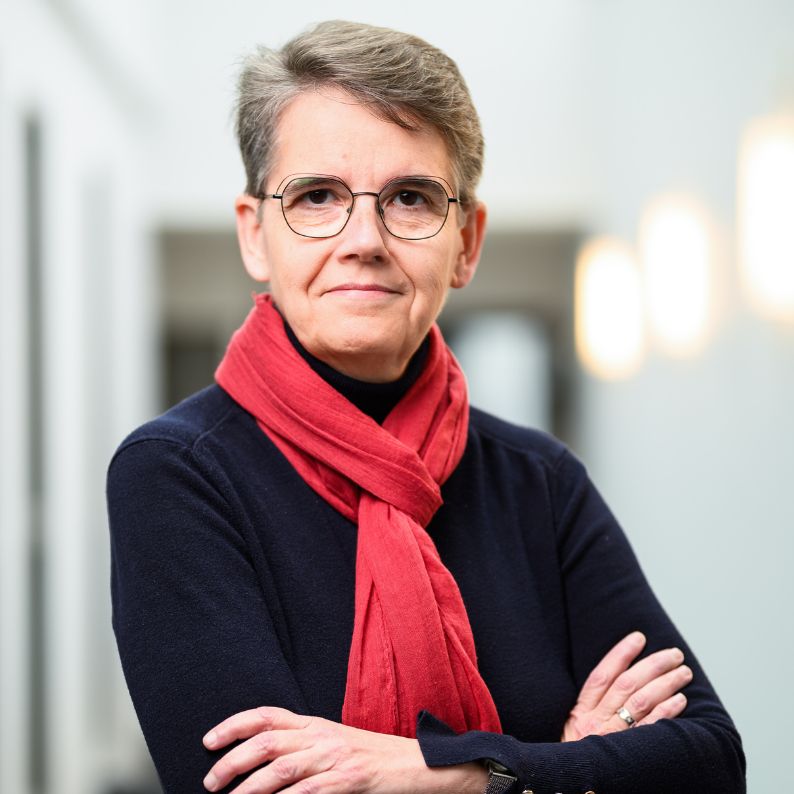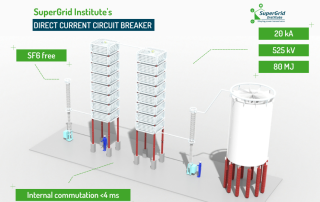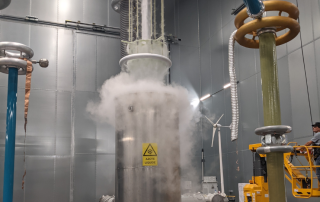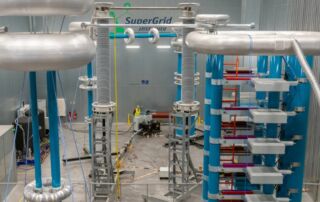Interview with Marie-Hélène Luton
Director of our HV Equipment & Cable Systems Department

We have decided to introduce you to some of the key people behind SuperGrid Institute – the experts driving our mission forward. In this edition, we are pleased to feature Marie-Hélène Luton.
With a strong industrial background and deep expertise in high voltage and direct current technologies, she took over as Director of HV Equipment & Cable Systems Department at the beginning of 2024.
In this interview, Marie-Hélène shares insights into her team’s current projects, the major challenges ahead in the energy transition, and what inspired her to join SuperGrid Institute.
You oversee the High Voltage Cable Systems Department at SuperGrid Institute. Can you talk to us about current innovations and key projects your team is working on?
Our key projects articulate around the following subjects:
The environmental issues require the gradual withdrawal of SF6 from high voltage equipment. We are studying the properties of alternative gases to SF6 for HVAC and HVDC applications, as well as knowing how to replace SF6 from equipment already in operation.
Regarding the substation equipment, we are developing new 525kV HVDC gas-insulated switchgear (GIS) without SF6. This work is part of the new consortium (Rhodé), that focuses on developing floating substations (GIS – gas insulated systems).
In the area of circuit breaking, we have been developing a direct current circuit breaker (DCCB) technology for several years now. This equipment is a key component in the development of multi-terminal HVDC grids. As a result of the positive outcomes obtained on prototypes, we signed a collaboration agreement with an industrial partner in 2024 to develop a 525kV DC solution.
The superconducting fault current limiter (RSFCL), when combined with a DCCB, offers a cost-effective and attractive solution for protecting DC power grids. These RSFCL are also being studied as part of the European project Scarlet, which aims to define hoc architectures for medium-voltage superconducting DC networks and their associated protection systems.
JIP Subsea Smart Hubs is another innovating project that was launched for the floating offshore wind industry. This project deals with various sponsors and technical advisors regarding the possible integration of subsea hubs to optimise the operation of these farms.
Our teams specialised in the characterisation of insulating materials (polymers, resins, or gases) are developing prototypes and testing methods to select the most suitable materials for HVDC applications. These factors help define design criteria and, through modelling, enable the sizing of new equipment. Currently, we are supporting various clients in selecting materials or designing equipment for DC applications. We are also contributing to the European project NewGen, in the aim to evaluate the performance of new recycled polypropylene-based cable insulation systems.
The reliability and lifespan extension of power networks represent another key challenge. We have developed tools to measure space charges and leakage currents in cable insulation systems. This expertise makes it possible to select the most suitable products for these applications. Specific sensors are also being developed for monitoring-type applications.
Finally, we have state-of-the-art dielectric and power testing laboratories that allow us to test both prototypes and full-scale equipment. We continuously upgrade our test facilities in line with the latest regulations and newly identified specific grid requirements. In 2024, we carried out transient overvoltage (TOV) characterisation tests on a 525kV cable system — one of the first tests of this kind in the world.
In your opinion, what will be the biggest challenges and opportunities for the energy sector in the years to come?
In response to environmental challenges, the two key priorities are extending the lifespan of existing equipment and the eco-designed systems.
Extending the lifespan of equipment requires diagnostic methods to assess the condition of the existing fleet. This requires a detailed understanding of the aging mechanisms of the equipment.
Eco-design is already evident in the use of new materials and recycled metals. For example, this includes replacing certain banned substances, such as the previously mentioned SF6, and gradually phasing out lead in submarine cables, both in existing and new equipment. The entire ecosystem and supply chain will be disrupted, and the reliability of networks must be maintained in a climate context that is particularly challenging for grids.
The development of MVDC networks, the optimisation of offshore wind systems, the floating stations, and the expansion of networks in congested areas such as large urban centres are other key challenges.
Finally, we are aiming to install additional equipment in the already crowded underground spaces of cities, at a time when data centres are significantly increasing their energy consumption. Therefore, we need to keep solutions that make it possible to transmit large amounts of power using minimal space and superconductivity could be the solution.
All this to say that there is still plenty of work to be done! The topics we are working on at SuperGrid Institute prove very relevant to meet these future challenges.
What were the key milestones in your career before joining SuperGrid Institute?
Right after completing my electrical engineering studies, I joined the underground transmission cable industry at the company Silec (now Prysmian). I was involved in the development and market launch of successive generations of 90kV, 225kV, and 400kV HVAC cables in close partnership with RTE at the time (which was still called EDF).
I then evolved, still in high voltage, in various roles both in France and abroad: tendering and project management.
A little anecdote to share with you: my first experience with direct current (DC) dates to the 1990s when I was just starting my professional career. At that time, DC was a completely marginal topic, with no identified market. Nevertheless, I was able to take part in exploratory work conducted with EDF on the possibility of using a land cable with extruded insulation for direct current. Twenty years later, the HVDC adventure caught up with me when I joined Nexans in 2014 to support the development of their HVDC cable ranges from 320kV to 525kV.
Then, with a strong interest in industrial challenges, I turned towards industrial operations and the development of manufacturing processes.
What led you to join our management team at Supergrid Institute?
After several years focused on operations and processes in the industrial sector, I was drawn to the opportunity to manage projects that tackle the major challenges of high-voltage direct current (HVDC). The fact that SuperGrid Institute’s activities aim not only to develop technological building blocks but, above all, to turn innovation into industrial reality ultimately convinced me.
And I must admit, a little inner voice told me: there’s no such thing as pure coincidence. You begin your career working on the development of underground HVAC connections, which were still in their early stages at the time. What greater adventure could there be than contributing now, nearly 35 years later, to the development of HVDC networks, where demand is rapidly growing at an incredible pace, and where so much remains to be explored, made reliable, and brought to life? For me, it’s incredibly motivating.
In your opinion, what added value does SuperGrid Institute bring to the industry?
For starters, it is our general view of the grid. The day to day exchanges we have with key network players, such as TSOs, equipment manufacturers, and material suppliers—give us an up-to-date, holistic understanding of the topics to be addressed, from technical and economic aspects to industrial considerations.
Our mission is to solve technological challenges that an individual industrial player could not tackle alone, as doing so often requires a broad range of technical expertise and testing capabilities that they may not have. By doing so, we support industry partners to help them move faster in their development processes and share the relevant know-how, thereby contributing to the accelerated market launch of their products.
Finally, the funding model for collaborative projects, for example through ITE programs, is beneficial for our partner companies. Combined with our status as an independent third party, this also helps our clients enhance the credibility of the results obtained in the eyes of all stakeholders.
How do you see SuperGrid Institute’s role in the transformation of the European energy sector over the next ten years?
The grid needs to become smarter, more sustainable and inclusive.
Renewable energies such as wind and solar power must continue to develop. We will continue to make sure of this with our partners, while supporting the circular economy by pursuing eco-design initiatives.
The studies already undertaken by SuperGrid Institute in its various areas of expertise (architecture, equipment, energy conversion and storage) will certainly be enhanced by greater use of artificial intelligence and consideration of cyber security issues.
More broadly, and by its very nature, SuperGrid Institute’s role as an aggregator, should also make a major contribution to the choice of interconnection network architectures.
What surprised you the most when you first arrived at SuperGrid Institute?
I do not know whether it surprised me but what I found very positive at SuperGrid Institute is the diversity across generations, cultures and skills profile. The senior employees interact with the younger employees, and technical profiles are complemented by others with extensive industrial experience. This creates an excellent balance of expertise, a deep understanding of our clients’ challenges, and fosters a daily exchange of knowledge that is extremely valuable. A successful melting pot!
Finally, what impresses me and still impresses me to this day, are the many results achieved by SuperGrid Institute in just one decade, making it a trusted third party and partner recognised by the industry for its expertise.





